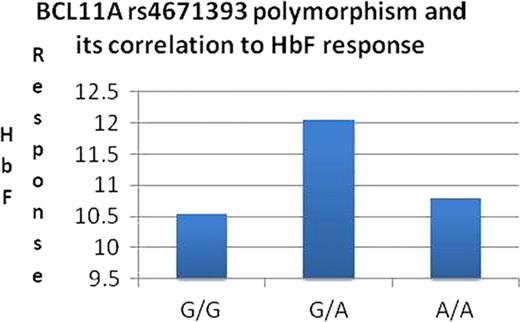Abstract
Abstract 1051
Several genetic polymorphisms are known to influence baseline hemoglobin F (HbF) levels in patients with sickle cell disease (SCD). These include XmnI polymorphisms in the Gγ globin promoter, polymorphisms of HBS1L-MYB and more recently BCL11A. Over the past several years, many studies have shown that polymorphisms in the BCL11A gene are strongly associated with baseline HbF levels in various populations with SCD. The strongest association has been found with a SNP (G→A) in the intron2 of the BCL11A gene (rs4671393). SCD patients on hydroxyurea (HU) therapy display a wide range of HbF responses. The factors underlying this heterogeneity are not clearly delineated. We undertook a study of the BCL11A rs4671393 polymorphism in a population of adult SCD patients who have been on HU therapy for an extended period. Fifty-nine African-American patients with SCD (25 male, mean age 33.9 and 34 female, mean age 34.5) were studied for BCL11A rs4671393 polymorphism and its correlation to HbF response (percent change in HbF from baseline to maximal response). The minor allele frequency (MAF) of A was 0.288. The distribution of HbF response (δHbF) was plotted against the genotype and is shown in the figure. As can be seen, patients with an A allele had a higher δHbF (12.1%) as opposed to those with the wild type (G/G), which was at 10.6%. Those homozygous for the minor allele (A/A) showed a 10.8% increase in HbF in response to HU therapy. These results are suggestive of a higher HbF response to HU when an A allele is present at this position. The number of homozygous for the minor allele are too small to reach a definite conclusion.
Disclosures:
No relevant conflicts of interest to declare.
Author notes
*
Asterisk with author names denotes non-ASH members.
© 2011 by The American Society of Hematology
2011


This feature is available to Subscribers Only
Sign In or Create an Account Close Modal